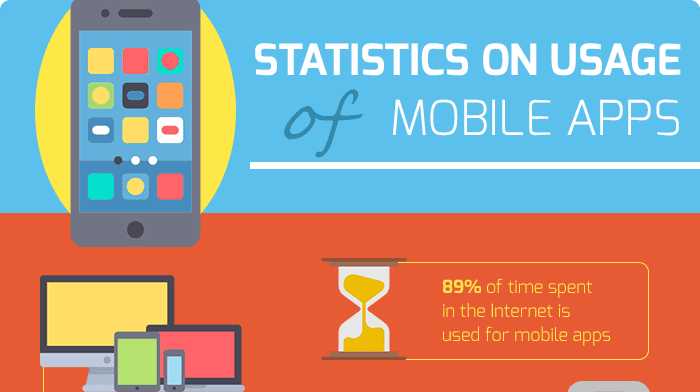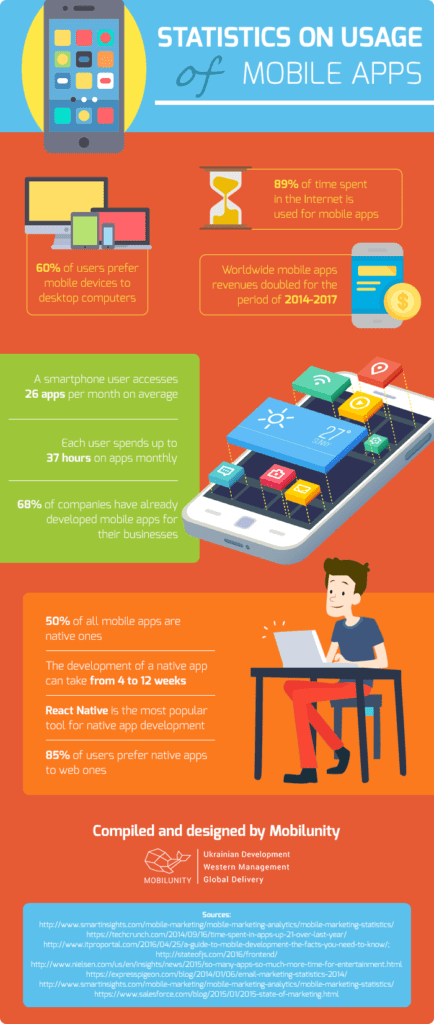Modern technologies occupy more and more places in the life of each of us. Most people own smartphones, tablet PCs or other devices to have constant access to the Internet and to control their smart devices as IoT continues to evolve constantly. Nowadays the very mobile devices, smartwatches, tablets are used as interfaces for connection with IoT devices. Taking into account a growing trend of gadgets popularity, every businessman should be aware that they need to keep up with the time, technologies, predict the future and needs of their customers and consumers. This leads to the necessity to transfer any business to the digital world not only in the form of a website and IoT device, but also in the form of a mobile application as this is an integral part of our contemporary life.
The popularity of mobile and IoT apps can’t be denied and here are some evidences that hint what the future will be like. Smart Insights conducted a research and stated that 80% of Internet users prefer to use smartphones (and smartwatches) for browsing. Moreover, according to the Express Pigeon, more than 50% of smartphone owners begin to use their gadgets immediately after waking up. Following this tendency, 68% of companies have already integrated a development and usage of mobile applications to their marketing strategy, as it is reported by Salesforce.
Hybrid & React Native Mobile Apps for IoT Projects
Many of us can’t imagine their lives without Uber, the tado Smart AC control, Yonomi, Gideon, Stringify, Thington, and many many other IoT apps regardless of the fact that they know nothing about IoT. This is a great example of how IoT is easily implemented into our everyday lives. The business owners of these projects may be considered real inventors, who didn’t just create the apps, but aimed at making the lives of their customers easier.
According to the survey of Red Hat, today 50% of companies look for specialists in mobile development for hire as they already have noticed the close relationship of mobile and IoT and plan to launch IoT projects for their businesses within the nearest 5 years. The following fact is even more surprising. Gartner conducted a research and stated that by the end of 2017 the demand for the development of mobile applications will grow five times faster than the number of IT companies able to meet this demand. This prediction is already becoming a reality and a great demand for React developers is observed worldwide for development of native and hybrid mobile applications.
Why React? Because, React Native is one of the most popular technologies to build native iOS and Android apps. Considering the above mentioned facts, stats on IoT projects, and trends, it is obvious that any React Native programmer will be able to develop an IoT application or project in the nearest future without difficulties or constraints.
Still, how is it possible for a business to define what type of IoT app is better: native or hybrid? Let’s see what features and differences both of them have.
Peculiarities of Native Mobile App Development
- Native development is intended for certain operating systems such as Android, iOS, Windows Phone, etc.
- Such apps are written in different programming languages used by software developers for a specific platform (for example, Swift and Objective-C for iOS; Java for Android).
- Many JavaScipt developers also use other tools or libraries to develop a native application.
- The main advantage of native applications is that they are optimized for specific operating systems, which means that they work correctly and quickly.
Some Facts About Hybrid Mobile Apps Development
- A hybrid application has this name because it combines some of the features of native and web ones.
- These mobile applications as well as native ones are downloaded from the application store, but the data is updated autonomously. Therefore, they need an Internet connection, but in some cases can work without it.
- Ionic is used to create such applications.
In general, customers of mobile development can be divided into 2 groups:
- First group requires the creation of complex, resource-intensive applications with multi-layered animation and computational functions;
- For the second group, applications with an adaptive interface are relevant, without complex animation and storing a large amount of data directly in the memory of the device.
It is obvious that native development is the best choice for the first group, while the hybrid approach meets the needs of the second one.
As we have already said, native IoT applications are more popular than hybrid and web ones. Until now, devs needed to write code from scratch for various operating systems and it was a major problem in creating native applications. This made the development process time-consuming and costly. However, at the moment this problem is solved with the help of React mobile development.
Based on our research, we may conclude that IoT applications and projects are only at their early stage of popularity. Most likely there will be even more IoT devices and apps invented that will make our cars fly, dinners to be cooked, and facilities to be self-maintained. In 21st century this can’t be in a different way, as IoT is about making our everyday life easier.




































